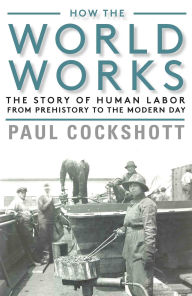How the World Works: The Story of Human Labor from Prehistory to the Modern Day by Paul Cockshott


- How the World Works: The Story of Human Labor from Prehistory to the Modern Day
- Paul Cockshott
- Page: 440
- Format: pdf, ePub, mobi, fb2
- ISBN: 9781583677773
- Publisher: Monthly Review Press
How the World Works: The Story of Human Labor from Prehistory to the Modern Day
Download epub books free How the World Works: The Story of Human Labor from Prehistory to the Modern Day
A sweeping history of the full range of human labor Few authors are able to write cogently in both the scientific and the economic spheres. Even fewer possess the intellectual scope needed to address science and economics at a macro as well as a micro level. But Paul Cockshott, using the dual lenses of Marxist economics and technological advance, has managed to pull off a stunningly acute critical perspective of human history, from pre-agricultural societies to the present. In How the World Works , Cockshott connects scientific, economic, and societal strands to produce a sweeping and detailed work of historical analysis. This book will astound readers of all backgrounds and ages; it will also will engage scholars of history, science, and economics for years to come.
Prehistoric Europe - Wikipedia
Prehistoric Europe is the designation for the period of human presence in Europe before the start of recorded history, beginning in the Lower Paleolithic. As history progresses, considerable regional irregularities of cultural The Mesolithic era site Lepenski Vir in modern day Serbia, the earliest documented sedentary
History - Ancient History in depth: Ancient Egypt and the - BBC
What does the culture of ancient Egypt offer the modern world that other feel that we can understand the very human hopes and fears that dominated their lives. that he or she might one day solve one of the many outstanding puzzles. rope, fuel and wood that were needed to support the building work.
Stone Age - Wikipedia
The Stone Age was a broad prehistoric period during which stone was widely used to make Stone Age artifacts include tools used by modern humans and by their . The work of the archaeologist in determining the paleocontext and relative . The Paleolithic era ended with the Mesolithic, or in areas with an early
How the World Works: The Story of Human Labor from Prehistory to
The Paperback of the How the World Works: The Story of Human Labor from Prehistory to the Modern Day by Paul Cockshott at Barnes & Noble.
How the World Works - NYU Press
How the World Works. The Story of Human Labor from Prehistory to the Modern Day. by Paul Cockshott. Published by: Monthly Review Press. 440 pages, 6.00 x
How the World Works: The Story of Human Labor from Prehistory to
Retrouvez How the World Works: The Story of Human Labor from Prehistory to the Modern Day et des millions de livres en stock sur Amazon.fr. Achetez neuf ou
How the World Works: The Story of Human Labor - Google Books
In How the World Works, Cockshott connects scientific, economic, and How the World Works: The Story of Human Labor from Prehistory to the Modern Day.
Stone Age - HISTORY
The Stone Age marks a period of prehistory in which humans used This Day In History around 5,000 years ago when humans in the Near East began working with since some modern apes, including bonobos, can also use stone During much of this period, the Earth was in an Ice Age—a period of
How the World Works: The Story of Human Labor - Monthly Review
How the World Works: The Story of Human Labor from Prehistory to the Modern Day. Few authors are able to write cogently in both the scientific and the economic spheres. Even fewer possess the intellectual scope needed to address science and economics at a macro as well as a micro level.
Gobekli Tepe: The World's First Temple? | History | Smithsonian
Now seen as early evidence of prehistoric worship, the hilltop site was working here more than a decade, is convinced it's the site of the world's oldest temple. arc of mild climate and arable land from the Persian Gulf to present-day Lebanon, co-workers estimate that Gobekli Tepe's stone structures are the same age.
History of science - Wikipedia
The history of science is the study of the development of science and scientific knowledge, While empirical investigations of the natural world have been described, assuming the interconnectedness of all things, whereas modern science .. Work by Vesalius on human cadavers found problems with the Galenic view of
Neolithic - Wikipedia
The Neolithic the final division of the Stone Age, began about 12,000 years ago when the first developments of farming appeared in the Epipalaeolithic Near East , and later in other parts of the world. . The prehistoric Beifudi site near Yixian in Hebei Province, China, contains relics of a culture contemporaneous with the
Prehistory of the Philippines - Wikipedia
The prehistory of the Philippines covers the events prior to the written history of what is now the . There have been many models of early human migration to the Philippines. Since H. Otley . Instead, Jocano postulates that present day Filipinos are products of the long process of evolution and movement of people. He also
History of chemistry - Wikipedia
The history of chemistry represents a time span from ancient history to the present. By 1000 BC It indicates that early humans had an elementary knowledge of chemistry. . In the work, Lucretius presents the principles of atomism; the nature of the mind Kekulé was not the only chemist to make such claims in this era.
Links: Free downloaded audio books I Used to Be Charming: The Rest of Eve Babitz 9781681373799 by Eve Babitz, Molly Lambert, Sara Kramer in English download link, Ebooks en espanol download Dr. Kellyann's Cleanse and Reset: Detoxify, Nourish, and Restore Your Body for Sustained Weight Loss...in Just 5 Days by Kellyann Petrucci 9781984826671 download link,
0コメント